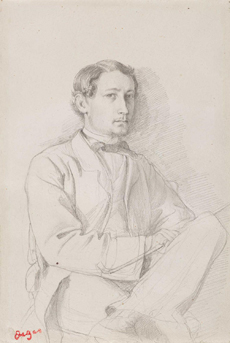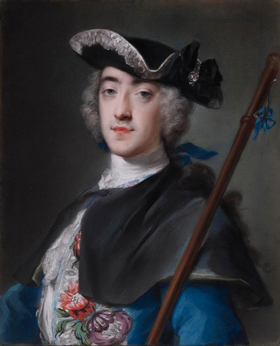No Longer a Cypher
John Haberin New York City
The Frick: Eveillard and Gregory Gifts
John Singer Sargent had a gift for polish and provocation. He could skim across the surface while hinting that something even more in violation of decorum lies beneath. Who else, after all, would title his most famous portrait after an enigma, Madame X?
In real life Virginie Amélie Avegno, or Madame Gautreau, was no cipher. Born in New Orleans, she commanded attention as a socialite in Paris. She commands attention in the painting as well. Hair up, arms to one side, face in profile, she rules over a spare interior—and, no doubt, over anyone who dares to question her bare shoulders and tight black dress.  Sargent himself found her a lot to handle. In the course of ten studies for the painting, she could not sit still.
Sargent himself found her a lot to handle. In the course of ten studies for the painting, she could not sit still.
She may not let her hair down, but she does take a load off her feet. In one pencil sketch she kneels on a sofa, her back to the artist, sticking out her heels. Sargent may have lost patience, but he must have been delighted to study her volume and actual billowing dress, like those in so many of his portraits. Now the study is part of a promised gift to the Frick Collection, at the Frick Madison. If it sounds classy, it is—no mere private collection, but the Eveillard gift. Yet it allows the artists and the Frick itself to loosen up.
Rosalba Carriera conceded nothing to the men around her in Venice, and neither do her sitters. A man and woman, known today only through her art, share haughty expressions and Rococo luxury. He dresses as a pilgrim, most likely a play on his last name, but without a trace of humility. He wears the hat of a soldier, and his pilgrim's staff could serve as a weapon. Floral patterns enliven his bearing, a close match to flowers pinned to the woman's white chemise beneath a bare shoulder. Carriera works in pastel, but it could almost be oil in its casual flair carrying their blue cloaks outward.
The two face each other, also at the Frick Madison, across a true wealth of decorative art, as if to claim it as their own. It has plenty of prior claimants. Its makers belonged to the most celebrated workshops in Europe, including Limoges (as in porcelain) and Gobelins (as in tapestry). They worked for Louis XIV in France and Augustus II, elector of Saxony and king of Poland, in the court at Dresden. They decorated the palace at Fontainebleau in the late Renaissance. Now the Frick Collection can claim them, too, as a bequest from Alexis Gregory on his death in 2020.
Artifice and shimmer
John Singer Sargent sounds only natural for the Frick. Think of the artifice and shimmer of its portrait by J. A. D. Ingres, the display of power in Sir Thomas More by Hans Holbein, the courtliness and extravagance of Jean-Honoré Fragonard and François Boucher, the precision of Jan van Eyck, Jan Vermeer's delicate balance, and the deeper insights of Rembrandt. Still, Sargent is new to the museum, like Rosalba Carriera, and his portraits of children, portraits of a prominent Jewish family, the Sassoons, and watercolors have exhibited elsewhere. Others are old favorites from the collection's home. If they fit right in, Elizabeth and Jean-Marie Eveillard are longtime trustees, and Betty serves as the board's chair. Still, in selecting just twenty-six works on paper (on top of the Eveillard gift of drawings coming shortly to the Morgan Library), the curators are happy to shake things up.
They have done so in bringing in a woman from Revolutionary France. Elisabeth Vigée Le Brun in 1784 finds her female sitter short on spectacle and utterly self-possessed. They have, too, in giving Edgar Degas a family history. Born to a French Creole mother and a banker from Italy, his travels took him in search of his heritage. Is he still the consummate Parisian, even at just twenty-three? You bet, and his Italian cousin has perfect composure, while his multiple shadows hint at what he refuses to express.
More often, though, art plays against the expected, with the illusion of spontaneity or reserve. A coquette for Fragonard throws back her head and stuffs her hands in her dress as if in her pockets, even as the shadow of her dress flares out with unaccustomed mass. A man for Jan Lievens in the golden age of Dutch painting throws his head back, too, while holding his hand to his chest. Pierre-Paul Prud'hon amid the Enlightenment presents a man, finger to his chin in indecision, between reason and pleasure. Pleasure looks much the better deal. A boy for Jean-Baptiste Greuze shrinks in fear of his father's curse, between the golden curls to one side of his head and his shadow to the other.
Others stick more closely to the moment. Jean Antoine Watteau observes hands and faces, while Eugène Delacroix looks to what he saw in North Africa. In Impressionist Paris, Gustave Caillebotte picks out a man stepping onto a curb in the rain. Cottages for Jean-François Millet barely rise above a marsh, but rich in life. John Constable creates a picture of turbulence several times over, as a horse leaps over a fence, trees sway in the wind, and clouds vie with sunlight. The stability of The White Horse and Salisbury Cathedral seems a long way away.
Yet detachment and the instant are themselves a pose. Fragonard goes back to touch up his red chalk with black, while Salvator Rosa brings three colors of chalk and four more of pastel to a lively, literate woman. She may also be a woman of the theater, like a pair for Nicolas Lancret, the student of Claude Gillot, in the 1720s and for Jules de Goncourt as much as one hundred and fifty years later. A copy after Boucher relies on quick parallel curves, or so it seems. In reality, it captures the semblance of crayon in a print, reversing the original hung to its right. But then you expect no less than an allegory from Boucher, who pierces the shield of a reclining shepherdess with an arrow to its literal heart.
The gift includes diverse media, from drawing to Constable in oil. It bows to chronological breadth as well, starting with an anonymous portrait in Renaissance Venice. Others are more studied or more showy, but then Giambattista Tiepolo always treats art history as spectacle, here with a scene from the Gospels. It may raise a smile, not least at my own expectations. Does a tambourine for Francisco de Goya almost dwarf its player? He, too, is a performer—and little more than an X.
A pilgrimage to luxury
This has been a good year for expanding the collection—and for the museum politics of repaying the donor with an exhibition. The Gregory gift follows the Eveillard gift and a woman's portrait by Giovanni Battista Moroni. He, too, seems most concerned for wealth and surfaces, to judge by her jewels and his late Baroque manner. Will visitors share their concerns? When the collection returns from the Frick Madison to its Fifth Avenue mansion, will they once more rush past such things on their way to Rembrandt and Jan Vermeer? I know I will, but think of the decorative arts as essential to the museum's mission.
These days craft and design have taken their place alongside fine art, like the black potters of Stone Bluff Manufactory or Gee's Bend quilting. Still, they have done so to recover outsider art and art by women—art on the cheap, not the art of excess. That excess, though, is meant to get your attention and to evoke a way of life. When the Frick's expansion is complete,  it will need the Gregory gift to display painting not in a white cube, but in context. It has long held art from Limoges under the direction of Pierre Raymond, sometime after 1560. Now it has work from his hand.
it will need the Gregory gift to display painting not in a white cube, but in context. It has long held art from Limoges under the direction of Pierre Raymond, sometime after 1560. Now it has work from his hand.
Not just kings can bask in luxury. When Giuseppe Penone worked at Sèvres for porcelain at the Frick last year, he must have loved to see his name paired with the brand. (One of those Carriera portraits has inspired a contemporary mural at the Frick, for all their Rococo lightness.) Even apart from its patronage, the work here speaks of privilege. In an enameled triptych, with a dozen sibyls as its wings, the Crucifixion has a courtly rhythm—right down to Mary's swooning and the Roman soldier whose lance wounds Jesus. When Jason encounters a dragon, he shows more concern for his courtly bearing than for confrontation.
Luxury speaks that much more in materials, from goldsmiths, metal workers, ceramicists, and jewelers. The miniature of a lion is so encrusted with gold and jewels that only wonder at its detail can save it. Gobelins depicts Jesus as a fair-haired child, meaning gilded hair. Louis XIV appears in gilt bronze on a porphyry base. Carved ivory supplies the hilt of a hunting knife while making it far too precious for hunting. Other materials include rhinoceros horn and, slightly less exotic, glazed earthenware.
Finally, luxury means over the top. It has to be, to reward a royal patron and to demand your attention. A snake slithers down from King Louis and his shield as he treads on a wild animal's paws, and the handle of a tankard sports a dragon. That miniature of a lion once held rare scents and substances. James Cox in England calls his clock on a rhino's back, from 1770, his "musical automaton." A chat bot has many ancestors.
The decorative arts still escape a comfortable art history. Dates and places keep coming with the word possibly. When you read "possibly seventeenth or nineteenth century," you can only smile. Yet Gregory took his work as a collector seriously, in a tradition going back to J. P. Morgan as collector—enough to have sold off two Impressionist paintings to continue it. For now, consider yourself on a pilgrimage to luxury. Pretend to rise above it, like Carriera's courtier, if you dare.

The Eveillard gift ran at the Frick Madison through February 26, 2023, the Gregory gift through July 9. A related review looks at the Eveillard gift of Dutch art to the Morgan Library




